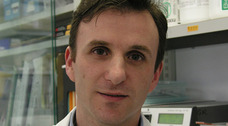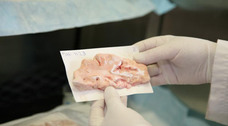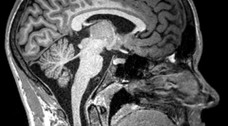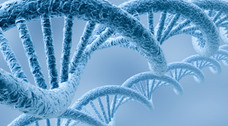2012-08-06

What goes on in the mind of a person who suffers from such intense anguish that suicide is the only escape? Researchers around the world have toiled with this question for decades, and now ground-breaking research is being conducted in this area thanks to the Douglas-Bell Canada Brain Bank and the work of Gustavo Turecki, MD. A psychiatrist specializing in genomics and researcher at the Douglas Institute, Dr. Turecki is also a Professor in the Department of Psychiatry at McGill University.
He and his colleagues from the McGill Group for Suicide Studies are exploring the effects of child abuse on the brain. Their goal? To examine the brain tissue collected from suicide completers in order to determine the consequences of childhood abuse and violence on gene activity.
The term epigenetics is used when environmental factors alter the function of genes; this is different from genetic mutation, which changes the structure of a gene. The good news is that changes in the regulation of gene function are potentially reversible, whereas those of gene structure are not.
From animal model to human model
A considerable number of mental disorder studies are based on animal models and this work has opened up some of the most innovative avenues of research. However, they are based on animal diseases that are similar—but not identical—to those observed in humans. “When it comes to depression, we have no idea what the animal is feeling. Although the behavioural symptoms are comparable, be it decreased psychomotor activity or impaired psychomotor function, they do not fully mimic the complexities of a human disease,” he said.
In fact, Dr. Turecki’s research arose as a result of studies conducted on rats. Two McGill University associates, researchers Michael Meaney and Moshe Szyf, established that the quality of maternal care rats received early in life modified the expression of genes involved in stress response. A young rat licked frequently by its mother will show less anxiety and better coping skills in stressful situations.
The benefits of licking show up in the rat’s hippocampus, that tiny brain structure that looks like a seahorse in humans, and is part of a brain system that plays a key role in memories and emotional reactions, such as aggressiveness, fear and pleasure.
The Brain Bank at the service of epigenetics

How exactly does this relate to humans? Could maternal care in humans have as profound an epigenetic impact as it has in rats? The Douglas-Bell Canada Brain Bank provided Dr. Turecki with a golden opportunity to explore this question. The genomics specialist repeated his associates’ experiment and targeted the stress-response gene, but this time in the human hippocampus.
The results of his study revealed how abuse can alter the epigenetic status of genes that control neural function and thereby adversely effect the NR 3C1 gene. Turecki, Meaney and Szyf discovered that the biochemical coating of this gene in the brains of abused individuals had undergone a change that influenced the production of stress hormones. When excessive amounts of these hormones are continually released into the body, an individual will be more susceptible to anxiety, depression and, in extreme cases, suicide.
According to Gustavo Turecki, it could be that the brain of an abused child receives a message that it is in a hostile environment. The brain responds by sending signals that prompt the child to be impulsive, aggressive, and defiant in order to survive a life-threatening situation.

The epigenetic effects of child abuse are not limited to the NR 3C1 gene. Recently, Dr. Turecki and his team identified other genes affected by child abuse in the regions of the brain involved in mood regulation. “We now have a more comprehensive understanding of the genome,” he said. “Some 300 genes showed evidence of a different epigenetic pattern in suicide victims compared to individuals who did not experience abuse. In particular, we identified a group of genes that control the development of the nervous system and are also involved in brain plasticity, that lifelong ability of the brain to reorganize neural pathways based on new experiences. This breakthrough is highly encouraging and we could not have achieved it without the brain bank.”
Gustavo Turecki and his team are keen to pursue this research and will be able to do so thanks to the brain samples obtained from the Douglas-Bell Canada Brain Bank. In time, they expect to gain a better understanding of suicide. The hope remains that earlier preventive measures and better treatments can be developed for individuals struggling with depression and suicidal thoughts. Who knows, perhaps the day will come when a cure is found for this illness that kills over one thousand people in Quebec per year.
Glossary
- DNA: DNA is the chemical name for the molecule that carries genetic instructions in all living things. The DNA molecule consists of two strands that wind around one another to form a shape known as a double helix.
- Gene: A segment of DNA considered a functional and physical unit of heredity passed from parent to offspring. It contains information for building the molecules, enzymes, proteins and cells that make up an organism and its systems.
- Genome: The entirety of an individual’s hereditary information encoded in their DNA . It is often compared to a book consisting of 46 chapters, equivalent to the 23 pairs of chromosomes that make up the genome.
- Gene expression: The process by which the information encoded in a gene is used to direct the assembly of a molecule, sort of like a “construction plan”. Depending on a variety of factors, the assembly is activated or deactivated; in other words, a given gene is expressed—or not.
- Control groups: Researchers in every scientific field use control groups to validate testing results. A control group is part of the scientific method in which data collected from test samples is compared with data collected from normal samples. The control group serves as a standard, or reference, and must contain samples whose quality is strictly controlled. By comparing the test samples with the control group, the researcher can tell whether the results are significantly different. This is the procedure Dr. Turecki’s team used on the brain bank specimens.



